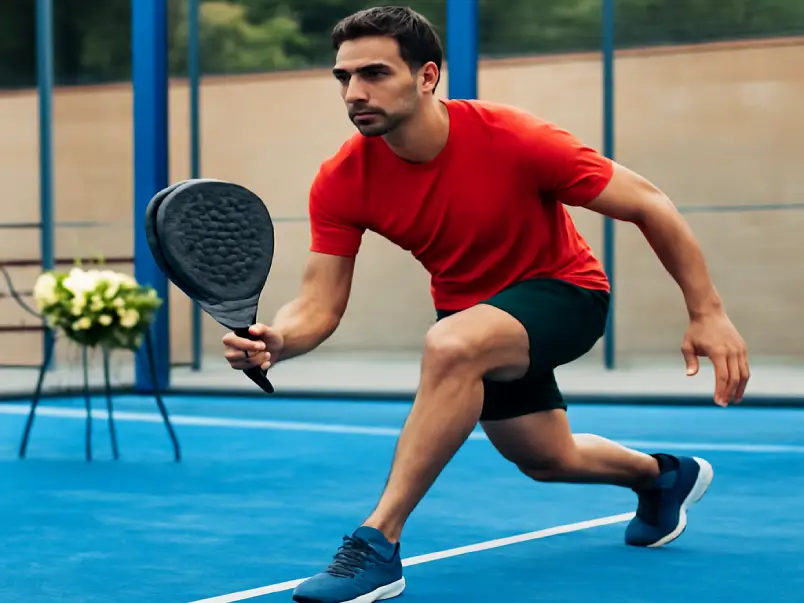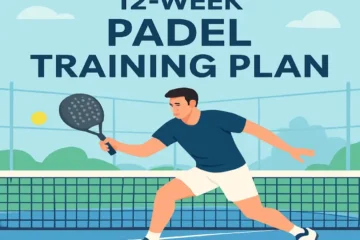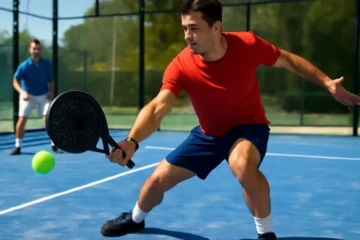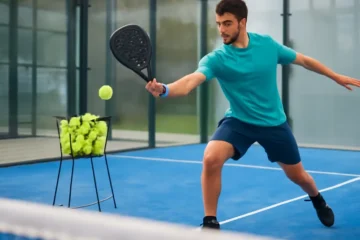Why Endurance Wins Matches
Have you ever found yourself gasping for breath in the middle of a tough padel match? Maybe your legs feel heavy, your focus starts to fade, or you begin making unforced errors that cost you crucial points. This scenario is all too familiar for padel players, especially during long matches that push your physical and mental limits. It’s in these moments when endurance truly becomes the deciding factor between winning and losing.
Padel isn’t like running a marathon; it’s a sport of explosive bursts of energy followed by quick recovery periods. It’s about sprints to the net, lateral shuffles across the court, and rapid recoveries between points. In short, padel demands a specialized type of endurance. So how can you train specifically for this kind of effort?
This guide will walk you through how to improve your endurance for padel, offering practical advice and a structured training plan to boost your stamina, reduce fatigue, and help you dominate on the court. By understanding the physical and mental components of padel endurance, you’ll learn how to last longer and make every point count.
I. Understanding Padel Endurance: It’s Not Just Running
To train for padel endurance, you must first understand the unique demands of the sport. While running may improve your overall fitness, padel requires much more than just a strong cardiovascular system. Here’s why:
A. The Stop-Start Nature of Padel
Padel is a high-intensity sport, characterized by explosive movements and quick changes in direction. Players sprint to the net, shuffle sideways, and often move rapidly from one side of the court to the other. These bursts of speed are followed by short recovery periods between points, making it more of an interval workout than a steady endurance activity like long-distance running.
The ability to recover quickly between these sprints and rallies is crucial. In padel, long rallies can drain your energy, but the quick points demand sharp focus and technique. Understanding this stop-start nature will help you tailor your training to mimic the on-court demands.
B. The Two Key Types of Endurance for Padel
Padel endurance is not a one-size-fits-all concept. It consists of two key components: aerobic endurance and anaerobic endurance.
- Aerobic Endurance – This is the foundation of your stamina. Aerobic endurance allows your body to sustain prolonged activity at a moderate intensity. For padel, aerobic endurance helps you recover quickly between points and stay energized throughout a match. A solid aerobic base will ensure that you can last longer on the court without feeling fatigued.
- Anaerobic Endurance – Padel’s explosive nature requires short bursts of high-intensity effort, which relies on anaerobic endurance. This is your body’s ability to perform high-intensity movements without the need for oxygen. It fuels those intense rallies where you hit multiple shots in a row, maintaining power and precision without tiring.
C. The Mental Game
Endurance in padel isn’t just physical—it’s mental too. Physical fatigue often leads to mental errors, such as poor decision-making or loss of focus. Building strong endurance will improve both your physical and mental stamina. When you’re not exhausted, you can stay mentally sharp, avoid errors, and maintain the strategy you’ve planned throughout the match.
II. Building Your Padel Endurance Foundation: The Training Pillars
To improve your endurance, you need to approach it from different angles. There are four essential training pillars to help you build the right foundation for padel.
A. Pillar 1: On-Court Padel-Specific Drills
The best way to improve your endurance for padel is by practicing on the court itself. Specific drills mimic the movements and demands of a real match.
- Ghosting Drills: These are movements practiced without a ball. By running through footwork patterns (such as shuffling or sprinting to specific spots), you can improve your cardio and muscle memory. This allows you to move efficiently without tiring yourself out.
- Multi-Ball Drills: A coach or training partner can feed balls to different areas of the court, simulating the variety and intensity of long rallies. This will help you get used to constant movement, similar to the unpredictability of a real match.
- Conditioned Games: To simulate real match conditions, play points where every rally must last a minimum number of shots (e.g., 5 shots per rally). This helps you practice maintaining energy levels over longer periods.
B. Pillar 2: Off-Court Cardiovascular Training
While on-court training is vital, off-court conditioning is equally important for building your aerobic and anaerobic endurance.
- Aerobic Base Building: Start with steady-state aerobic activities like jogging, cycling, or swimming. Aim for 30-45 minutes at a moderate pace where you can maintain a conversation. Doing this 1-2 times per week will improve your overall fitness and help your body recover faster during rest periods between rallies.
- High-Intensity Interval Training (HIIT): This is the most effective off-court workout for padel endurance. HIIT mimics the stop-start nature of the sport, improving both aerobic and anaerobic endurance. Try a session that includes 30 seconds of sprints followed by 90 seconds of walking or light jogging, repeating this cycle for 8-10 rounds. Other great HIIT exercises include stationary bike sprints, burpees, and shuttle runs.
C. Pillar 3: Strength and Power Conditioning
Endurance isn’t just about stamina; it’s about having the strength to move with power and precision. Strong muscles are more efficient and resistant to fatigue.
Focus on strengthening key muscle groups for padel:
- Legs: Lunges, squats, and plyometric exercises will help build the lower-body strength needed for fast starts and lateral movements.
- Core: A strong core is essential for stability during volleys and smashes. Planks, Russian twists, and leg raises will build endurance in this area.
- Upper Body: Exercises like push-ups and rows will help you generate more power for overhead shots and maintain good form during rallies.
D. Pillar 4: Flexibility and Mobility
To ensure you’re able to move freely on the court and avoid injury, flexibility and mobility are crucial. Incorporating dynamic stretching before matches and static stretching afterward will enhance your range of motion and muscle recovery.
III. Your Sample Weekly Padel Endurance Training Plan
Creating a structured routine can help you progressively build endurance. Here’s a sample weekly training plan designed for an intermediate padel player:
- Monday: On-Court Session (Focus on technique and footwork drills)
- Tuesday: Strength & Conditioning (Full-body workout) + Flexibility (Yoga or stretching)
- Wednesday: HIIT Session (20-minute high-intensity interval workout on the bike or treadmill)
- Thursday: On-Court Session (Focus on conditioned games and longer rallies)
- Friday: Active Recovery (Light aerobic activity, such as a 30-minute walk or swim) OR Rest
- Saturday: Match Day (Apply your endurance in a real match environment)
- Sunday: Rest (Critical for recovery and muscle adaptation)
This plan alternates between on-court training, strength conditioning, and recovery to ensure consistent progress without burnout.
IV. Fueling for Stamina: Nutrition and Hydration
Your training and performance won’t be as effective if you neglect your nutrition and hydration. Proper fueling ensures that your body has the energy it needs to perform at its best.
A. Nutrition as Fuel
- Pre-Match: Eat a meal rich in complex carbohydrates (like oats or whole-grain pasta) 2-3 hours before your match. This will provide sustained energy throughout your play.
- During Match: Keep your energy levels up with easy-to-digest carbs. A banana or energy gels are perfect for quick fuel during long matches.
- Post-Match: Refuel with a combination of protein and carbohydrates to speed up recovery. Chocolate milk, a protein shake, or chicken with rice can help replenish glycogen stores and repair muscles.
B. Hydration is Non-Negotiable
Hydrate throughout the day—not just during the match. Water is essential, but electrolyte drinks are key during intense sessions or long matches to replace lost minerals.
V. Tracking Your Progress and Recovery
How do you know your endurance is improving? Here are a few signs:
- You feel fresher and more focused during the third set.
- Your heart rate recovers faster between points.
- You can maintain proper form during extended rallies.
Also, don’t forget the importance of recovery. Sleep and rest days allow your muscles and cardiovascular system to adapt to the stress of training. Without adequate rest, your endurance won’t improve.
Conclusion: From Gasping to Dominating
Padel endurance isn’t just about being able to run longer distances; it’s about explosive energy, rapid recoveries, and maintaining focus throughout a match. By building your aerobic and anaerobic endurance, strength, and mobility, you can improve your game and outlast your opponents.
Remember, consistency is key. It’s better to train steadily and progressively than to overdo it with sporadic, intense sessions. Stick to your training plan, fuel your body properly, and track your progress. With dedication, you’ll be able to play smarter, think clearer, and enjoy padel at its highest level.
FAQs:
- What is the best way to train for padel endurance?
The best way to train for padel endurance is a mix of on-court drills, off-court cardiovascular training, strength conditioning, and flexibility exercises. On-court drills like ghosting, multi-ball, and conditioned games mimic match conditions, while off-court training with HIIT and aerobic exercises builds stamina. Strength and flexibility are essential for injury prevention and power. - How important is HIIT for padel training?
High-Intensity Interval Training (HIIT) is crucial for padel because it mimics the sport’s stop-start nature. HIIT improves both your aerobic and anaerobic endurance, helping you recover quickly between points and maintain power during explosive movements like sprints and smashes. - How often should I train for padel endurance?
A well-balanced routine includes 2-3 on-court sessions, 1-2 strength and conditioning workouts, and 1-2 HIIT sessions per week. Active recovery and rest days are also essential to prevent overtraining and allow for muscle recovery. - What should I eat to improve my padel endurance?
For better endurance, focus on a diet that includes complex carbohydrates for pre-match energy, quick-digesting carbs during the match for sustained energy, and a combination of protein and carbs for post-match recovery. Hydration is key, so drink water consistently and consider electrolyte drinks for longer matches. - How can I track my progress in padel endurance?
You can track your progress by noticing improvements in your performance during matches. Signs include feeling fresher in the later sets, faster heart rate recovery between points, and maintaining technical form during long rallies. Monitoring these changes over time will show how your endurance has improved. - What are the benefits of flexibility and mobility training for padel?
Flexibility and mobility training prevent injuries and allow for more fluid movement on the court. Dynamic stretching before play and static stretching afterward can improve your range of motion, helping you move quickly and efficiently during a match.




